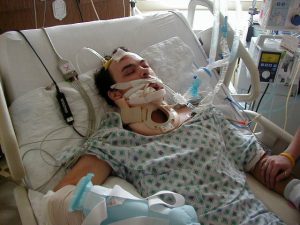 POSTEROLATERAL ANGLE POINT POSITION (PAPL OR POPE):
POSTEROLATERAL ANGLE POINT POSITION (PAPL OR POPE):
The posterolateral angle corresponds to the posterolateral capsular reinforcement of the knee. Its isolated involvement is rare (1.6%), it is most often associated with that of the central pivot, but it compromises the rotatory and posterolateral stability of the knee. The PAPL consists of:
– lateral head of the gastrocnemius;
– posterolateral condylar shell;
– posterior horn of the ML (lateral meniscus);
– popliteal muscle and tendon;
– fibroblastoma;
– Fabellofibular ligament;
– arched popliteal ligament and the iliotibial band.
From a functional point of view, it is indissociable from the lateral collateral ligament (LCL or collateral collateral ligament).
Clinic:
PAPL can be injured in acute, sports trauma (contact sports), or chronic in repeated instability accidents on chronic laxity (by early ACL rupture). Isolated PAPL lesions are rare. Most often there is an associated rupture of the central pivot and / or the medial plane and the MM.
The clinic is poor, both in the acute and the late stages, and the different maneuvers to test the angle are either not feasible (acute) or not very precise (chronic).
MRI:
The precise balance can only be based on it.
DP FS sequences 3 planes.
The small ligaments (fibrous popliteal, fabellofibular, arched) are hardly visible. But one can appreciate the hypersignals which correspond to their avulsion.
A hypersignal T2 from the upper end of the fibula should draw attention to the IPO. A more extensive hypersignal (fibula head, posterolateral border of the proximal end of the fibula) usually corresponds to a lesion of LCL, biceps tendon or joint tendon. A hypersignal limited apex of the fibula evokes a lesion of the small ligaments.
A recent study by Theodorou et al. has shown that the relevance of MRI for the detection of lesions of the iliotibial band, biceps tendon, gastrocnemius tendon, popliteal tendon, LCL, LCA, LCP, MM ML and osteochondral lesions ranged between 80 and 100%.
MISCELLANEOUS BRAKE LINES OF SIDE MISCELLANEOUS:
In the event of rupture of the LCA, rupture of the meniscotibial attachment of the ML exists in 9.8% of the cases, associated with a radial or complex fissure of the meniscus and a meniscal expulsion.
This lesion is also associated with a greater prevalence of absence of the meniscofemoral ligament.
